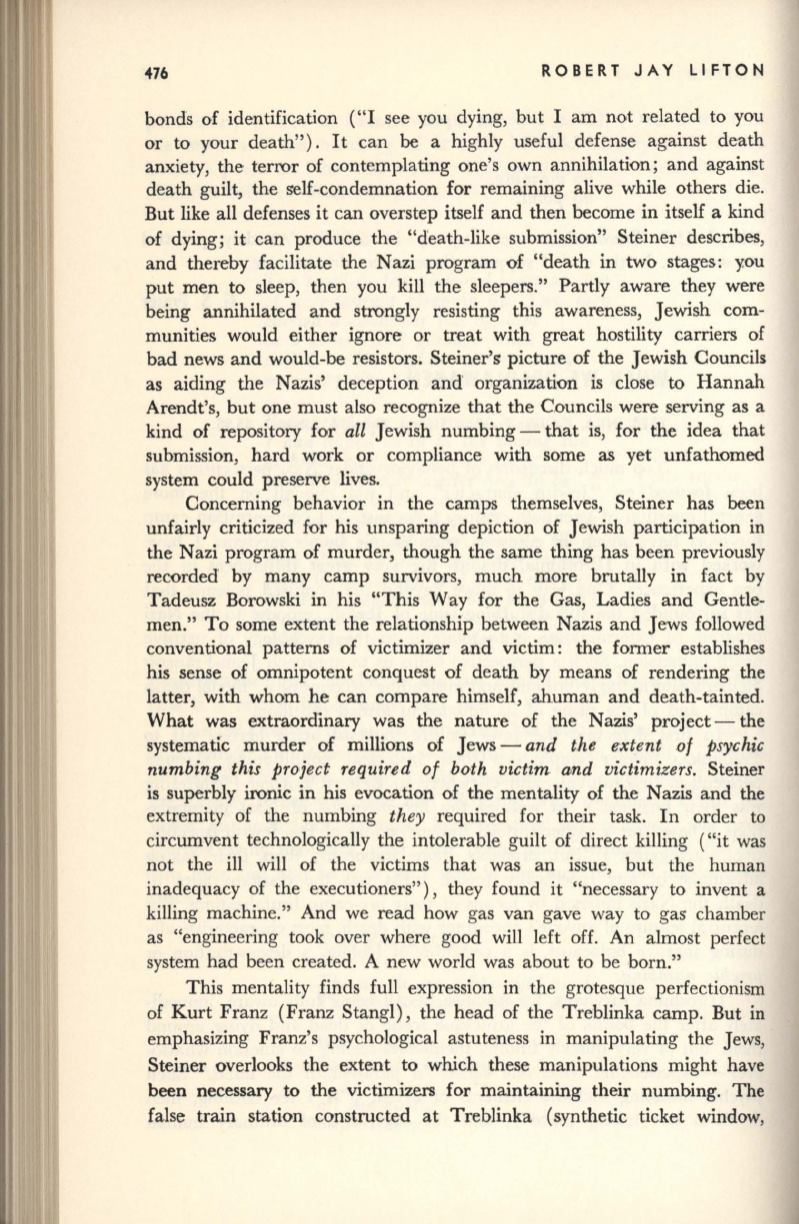
476
ROBERT
JAY
LIFTON
bonds of identification ("I see you dying, but I am not related to you
or to your death").
It
can be a highly useful defense against death
anxiety, the terror of contemplating one's own annihilation; and against
death guilt, the self-condemnation for remaining alive while others die.
But like all defenses it can overstep itself and then become in itself a kind
of dying; it can produce the "death-like submission" Steiner describes,
and thereby facilitate the Nazi program of "death in two stages: you
put men to sleep, then you kill the sleepers." Partly aware they were
being annihilated and strongly resisting this awareness, Jewish com–
munities would either ignore or treat with great hostility carriers of
bad news and would-be resistors. Steiner's picture of the Jewish Councils
as aiding the Nazis' deception and organization is close to Hannah
Arendt's, but one must also recognize that the C.ouncils were serving as a
kind of repository for
all
Jewish numbing - that is, for the idea that
submission, hard work or compliance with some as yet unfathomed
system could preserve lives.
Concerning behavior in the camps themselves, Steiner has been
unfairly criticized for his unsparing depiction of Jewish participation in
the Nazi program of murder, though the same thing has been previously
recorded by many camp survivors, much more brutally in fact by
Tadeusz Borowski in his "This Way for the Gas, Ladies and Gentle–
men." To some extent the relationship between Nazis and Jews followed
conventional patterns of victimizer and victim: the former establishes
his sense of omnipotent conquest of death by means of rendering the
latter, with whom he can compare himself, ahuman and death-tainted.
What was extraordinary was the nature of the Nazis' project- the
systematic murder of millions of Jews -
and t.he extent .of psychic
numbing this project required of both victim and victimizers.
Steiner
is superbly ironic in his evocation of the mentality of the Nazis and the
extremity of the numbing
they
required for their task. In order to
circumvent technologically the intolerable guilt of direct killing ("it was
not the ill will of the victims that was an issue, but the human
inadequacy of the executioners" ) , they found it "necessary to invent a
killing machine." And we read how gas van gave way to gas chamber
as "engineering took over where good will left off. An almost perfect
system had been created. A new world was about to be born."
This mentality finds full expression in the grotesque perfectionism
of Kurt Franz (Franz Stangl) , the head of the Treblinka camp. But in
emphasizing Franz's psychological astuteness in manipulating the Jews,
Steiner overlooks the extent to which these manipulations might have
been necessary to the victimizers for maintaining their numbing. The
false train station constructed at Treblinka (synthetic ticket window,


